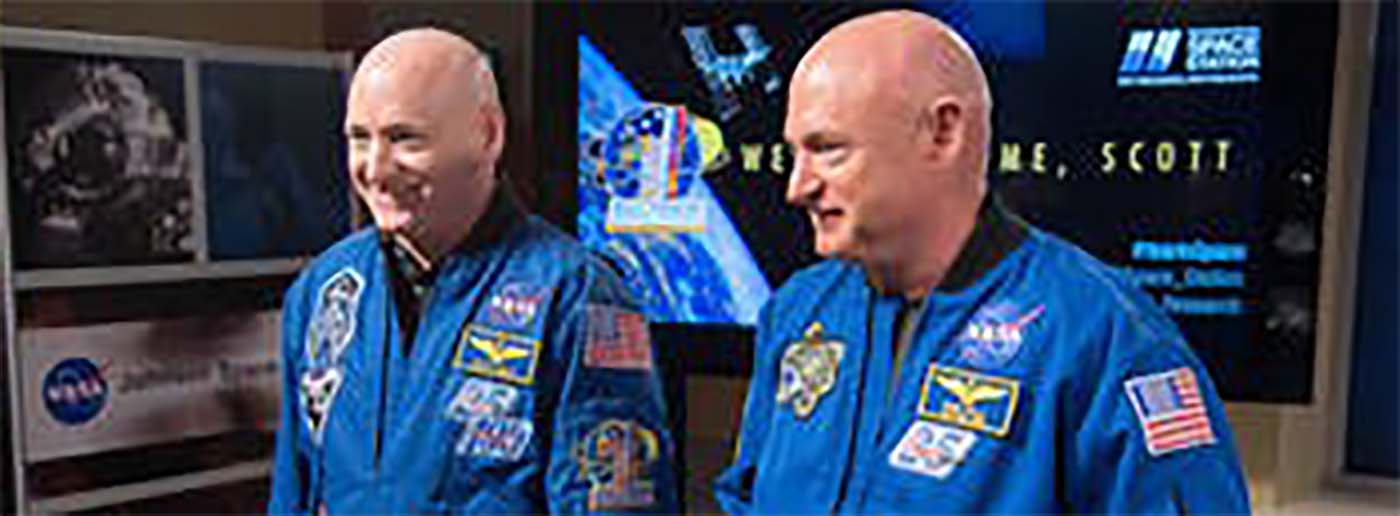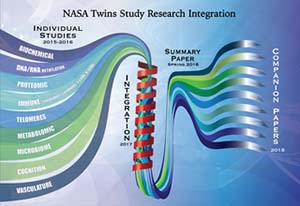The Twin Study propelled NASA into the genomics era of space travel. It was a ground-breaking study comparing what happened to astronaut Scott Kelly, in space, to his identical twin brother, Mark, who remained on Earth.
 The perfect nature versus nurture study was born.
The perfect nature versus nurture study was born.
The Twins Study brought ten research teams from around the country together to accomplish one goal: discover what happens to the human body after spending one year in space.
NASA has a grasp on what happens to the body after the standard-duration six-month missions aboard the International Space Station, but Scott Kelly’s one-year mission is a stepping stone to a three-year mission to Mars.
If the results of the Twins Study are like a play, Act 1 began at NASA’s Human Research Program(HRP) 2017 Investigators’ Workshop (IWS), where the ten teams presented their preliminary findings.
Reports included data on what happened to Scott Kelly, physiologically and psychologically, while he was in space, and compared the data to Mark Kelly, as a control subject on Earth. The 2018 IWS is Act 2, where findings from 2017 were corroborated, with some additions.
Researchers also presented what happened to Scott after he returned to Earth, again while making comparisons to Mark.
Act 3 will be debuted later in 2018 when an integrated summary publication is expected to be released.
By measuring large numbers of metabolites, cytokines, and proteins, researchers learned that spaceflight is associated with oxygen deprivation stress, increased inflammation, and dramatic nutrient shifts that affect gene expression.
After returning to Earth, Scott started the process of readapting to Earth’s gravity. Most of the biological changes he experienced in space quickly returned to nearly his preflight status. Some changes returned to baseline within hours or days of landing, while a few persisted after six months.
Scott’s telomeres (endcaps of chromosomes that shorten as one ages) actually became significantly longer in space. While this finding was presented in 2017, the team verified this unexpected change with multiple assays and genomics testing. Additionally, a new finding is that the majority of those telomeres shortened within two days of Scott’s return to Earth.
Another interesting finding concerned what some call the “space gene”, which was alluded to in 2017. Researchers now know that 93% of Scott’s genes returned to normal after landing. However, the remaining 7% point to possible longer term changes in genes related to his immune system, DNA repair, bone formation networks, hypoxia, and hypercapnia.
Increasing mission duration from the typical six-month ISS mission to one year resulted in no significant decreases in Scott’s cognitive performance while inflight and relative to his twin brother Mark on the ground.
However, a more pronounced decrease in speed and accuracy was reported postflight, possibly due to re-exposure and adjustment to Earth’s gravity, and the busy schedule that enveloped Scott after his mission.
 The detail
The detail
Compiling comprehensive genetic profiling research on identical twins is no easy feat. Science takes time, and two years of research has produced some interesting results.
An investigation focused on Telomeres was conducted by Susan Bailey of Colorado State University.
Telomeres protect or “cap” the ends of chromosomes, and decrease in length as a person ages.
In 2017, Bailey’s team reported that Scott’s telomeres significantly increased in average length while he was in space. Postflight measurements showed that his telomeres shortened in length within about 48 hours of landing, then stabilised to nearly preflight levels.
On Earth, Mark’s telomere length remained relatively stable. Reasons for the lengthening of Scott’s telomeres in space are still under investigation, but may be from his rigorous exercise regime and restricted caloric intake while on the space station.
The Biochemical Profile investigation, led by Scott M. Smith of the NASA Johnson Space Center, found that Scott Kelly’s body mass dropped during flight. His folate status was low before flight, but his folate went up while inflight, likely due to better food choices from the space food system.
Kelly’s body mass decline and folate increase coincide with Bailey’s findings of telomere lengthening. Smith agrees the healthier lifestyle could have resulted in lengthening telomeres.
Mathias Basner of the University of Pennsylvania studied Cognition by having the twins perform 10 tests covering a range of cognitive domains. These tests were conducted multiple times throughout the preflight, inflight, and postflight stages of the mission.
As reported in 2017, Basner found that increasing the mission duration from the typical six-month mission to a year resulted in no significant decreases in Scott’s cognitive performance while inflight and relative to his twin brother, Mark.
However, a more pronounced decrease in speed and accuracy postflight was reported. Possible reasons include re-exposure and adjustment to Earth’s gravity, and the busy schedule that enveloped Scott after his mission.
Emmanuel Mignot of Stanford University studied the Immunological responses of the twins by introducing them to the flu vaccine preflight, inflight (for Scott) and postflight – each at one year intervals.
Following each vaccination, both twins had an increased immune cell response to the flu at comparable levels. This is the expected response, protecting the human body from contracting the flu virus.
The year-two flu vaccines, on the ground and in space, yielded similar immune responses in each twin, leading to the conclusion that the flu vaccine given aboard the space station produces the expected immune stimulating effects inflight as well as on the ground.
The Longitudinal Integrated Multi-omics Analysis investigator, Mike Snyder, (Stanford University) reported at the 2017 IWS that altered levels of a lipid panel in Scott indicated inflammation while in space.
On the ground, Mark’s data indicated similar but lesser inflammation.
Snyder then measured the levels of cytokines, which are proteins that have an effect on cell interaction in well-known blood markers that indicate inflammation.
Snyder’s team found two strong indications of inflammation in Scott. One was a spike in a group of cytokines just after his return to Earth that remained elevated for six months. The other was a set of cytokines that were elevated before flight and remained elevated throughout Scott’s mission.
Snyder also found elevated levels of some proteins known to help maintain normal insulin activity to regulate blood sugar after meals in the flight twin.
The vast community of bacteria that live in the gastrointestinal tract play a major role in human health. Fred Turek, of Northwestern University, conducted the Microbiome investigation.
Turek reported that differences in the microbiome between the twins were pronounced at all timepoints. These differences were not altogether unexpected, due to differences in the diet, environment, and levels of individual immunity between the brothers.
Scott’s microbial species while in space were different than preflight, most notably there was a decreased presence of the bacterial phylum Bacteroidetes. However, as reported at the 2018 IWS, the changes did not persist upon Scott’s return to Earth.
Overall, the changes observed inflight were not greater than what might occur in one, on the ground, who makes changes to their diet or is exposed to illness.
Chris Mason of Weill Cornell Medicine investigated the genetic, epigenetic, and transcriptional dynamics of each twin. By studying how space travel can influence chemical changes in RNA and DNA, new “space genes” were reported, indicating significant cell stress and correlations with changes noted by other Twins Study investigators (including fluctuations in “epigenetic age”).
Whole-genome sequencing showed each twin has hundreds of unique mutations in their genome, more than expected, and some were found only after spaceflight, circulating in the blood as “cell-free DNA”.
This is thought to be from the stresses of space travel, which can cause changes in a cell’s biological pathways and ejection of DNA and RNA.
Such actions can trigger the assembly of new molecules, like a fat or protein, cellular degradation; and can turn genes on and off, which change cellular function. Significant responses were found for at least five biological pathways in Scott during his time in space.
These responses are important for future missions: hypoxia (likely from lack of oxygen and high CO2 levels); mitochondrial stress and increased levels of mitochondria in the blood (indicating damage to the “power plants of cells”); telomere length, DNA damage, and DNA repair (likely from radiation and caloric restriction); collagen, blood clotting, and bone formation (likely from fluid shifts and zero gravity); and hyperactive immune activity (from the new environment).
Although 93% of genes’ expression returned to normal postflight, a subset of several hundred “space genes” were still disrupted after return to Earth.
Andy Feinberg of Johns Hopkins University studied Epigenomics, or how chemical changes in the genome affected by environment differed between the twins over the course of the mission.
They found that the epigenetic changes detected in Scott during spaceflight were well within the range of variability of his twin on Earth. However, at specific regions of the genome in two populations of white blood cells, Feinberg found chemical modifications (methylation) to Scott’s DNA were altered while inflight (including regions near a gene regulating telomeres and a gene encoding collagen), consistent with measurements by the other twins’ investigators.
However, all returned to baseline upon return. These results open the door to epigenomic measurements of astronauts on long-duration space missions to assess potential genome damage during flight.
Stuart Lee of KBRWyle at NASA Johnson Space Center’s Cardiovascular and Vision Lab studied Metabolomic and Genomic Markers of Atherosclerosis(hardening and thickening of the arteries) to examine how inflammation and oxidative stress during spaceflight influences vascular structure and function.
he twins’ arteries were examined with ultrasound and they provided blood and urine samples throughout the duration of the mission. Biomarkers of inflammation were elevated and the carotid artery wall was thickened in Scott during and immediately after his mission, but no changes were observed in Mark.
Whether this adaptation is reversible or indicative of an accelerated progression of atherosclerosis in Scott compared to Mark remains to be determined; further observation is needed to understand the significance of these findings.
Brinda Rana of the University of California studied proteins in urine (Urine Proteomics) to see if protein pathways may adapt to spaceflight in response to fluid shifts.
Proteins identified in urine samples may be biomarkers; they may indicate physiological manifestations of spaceflight, such as muscle and bone deconditioning, metabolic and cardiovascular changes. Rana’s hypothesis was mostly confirmed, finding that proteins involved in fluid regulation and musculoskeletal formation were differentially excreted during spaceflight, as compared to Mark on the ground.
For example, Rana’s group found that a protein, AQP2, was elevated in urine collected from Scott in space and this elevation correlated to higher levels of plasma sodium during spaceflight. AQP2 regulates water reabsorption in the body and is a useful indicator of hydration or dehydration status.
